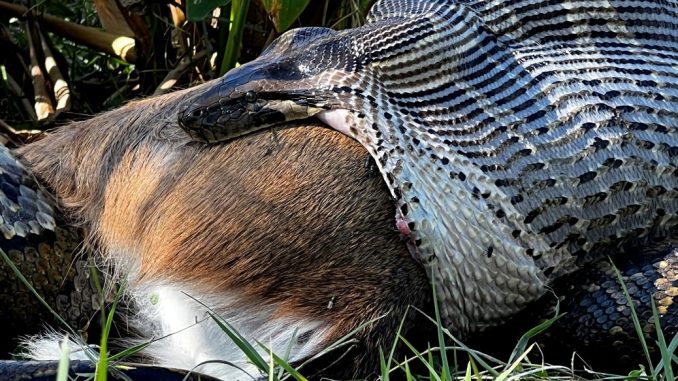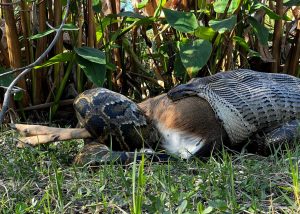
“So when Ian started shouting with excitement, I knew something was going on,” Bartoszek told Outdoor Life about an encounter they had with a python on December 19, 2022. That moment became the subject of a new study, reinforcing just how damaging these invasive snakes can be to native wildlife.
It was the height of python breeding season, and the snake removal team was working a typical day in a region near Naples that Bartoszek calls the Western Everglades. Using telemetry equipment, they tracked one of their male scout snakes, Ronan, hoping it would lead them to a large breeding female, their main target for removal. As they approached the area, dropping down a levee into a drained retention pond, they found more than expected.
“We saw this large female python halfway through swallowing a full-sized whitetail deer,” Bartoszek said, as he and Easterling crouched with their two interns to observe and photograph the scene. “Once the snake realized we weren’t a threat, it continued to finish its meal. It’s difficult to put into words unless you’ve seen it yourself, but it was as raw and primal as it gets … We watched as the snake swallowed the deer, hooves and all, in one piece.”
For Bartoszek, the sight was both shocking and a confirmation. Shocking, because no scientist in Florida had ever documented a python consuming a full-grown whitetail deer. But for years, he had suspected this kind of predation was happening on a larger scale in South Florida, with his team previously finding evidence of pythons preying on smaller deer. (In their native regions of Africa, Asia, and Australia, pythons have been known to consume full-sized deer.)
“Personally, I’ve been sounding the alarm for over a decade, telling people, ‘Hey, they’re eating our deer in significant numbers,’” Bartoszek said. “It took a while for some to catch on, but this is what we’re seeing now.”
Around a decade ago, Bartoszek’s team captured a 31.5-pound Burmese python that regurgitated a 35-pound whitetail. A subsequent study found this was the largest recorded prey-to-python size ratio for the species. In July 2022, they discovered deer remains in the stomach of a 215-pound snake, which remains the heaviest Burmese python ever captured in Florida. However, the December encounter was different because it involved a full-sized deer, and the researchers were able to witness the entire feeding process. Bartoszek estimated it took about 30 minutes for the snake to swallow the back half of the deer.

“Another fascinating detail was how the snake positioned itself,” Bartoszek added. “Its body near the tail was corkscrewing, gripping the deer’s hind legs and helping feed it into its mouth. These are remarkable animals.”
After the python fully consumed the deer, Bartoszek and Easterling subdued the snake and applied pressure to make it regurgitate the deer, making it easier to carry out of the area. The deer weighed 77 pounds (South Florida whitetails tend to be smaller than those elsewhere), while the python weighed approximately 115 pounds and measured just under 15 feet long.
“This just reinforces what we know,” Bartoszek said. “If anyone doubts the impact these snakes are having in South Florida, they are undoubtedly consuming their way through the Everglades’ food web, including whitetail deer.”
A New Scientific Opportunity
Besides providing stunning visual evidence of Burmese python behavior in Florida, this incident also offered Bartoszek’s team the chance to contribute to ongoing research on the species. After euthanizing the python, Bartoszek contacted Dr. Bruce Jayne from the University of Cincinnati, who specializes in snake biology, including the measurement of snake gape size — how wide they can open their mouths due to their unique jaw structure.
“When Dr. Jayne saw the photos and videos, he was astonished,” Bartoszek said, explaining that he kept the snake’s head and part of its neck frozen in a block of ice for further examination. “When he came down about a month later, we had that python and two others from the Big Cypress area, including a 19-foot snake, the longest ever measured in Florida.”
Dr. Jayne used custom-made plastic probes to measure the maximum gape size of the snakes. He determined that all three had a maximum gape of 26 cm, a significant increase from the previously recorded 22 cm, which was published in a peer-reviewed journal. According to Bartoszek, the finding establishes a new benchmark for studying these snakes, though he suspects some may have an even greater gape.
Implications for Florida Wildlife
This new understanding of Burmese pythons’ capabilities helps researchers better predict the ecological impacts these invasive snakes could have as they spread. The more closely scientists examine these effects, the more concerning Florida’s python problem becomes.
For example, years ago, Florida researchers were skeptical about reports of declining populations of medium-sized mammals, such as raccoons and rabbits. However, after one study tracked marsh rabbits using collars, it was discovered that 77 percent of them ended up inside pythons within six months.
Bartoszek suspects a similar situation may be occurring with whitetail deer, though no study has been conducted using collared deer in the core python range. He predicts that if such a study were performed, many collars would end up inside pythons, as they’ve already found evidence of fawns and smaller deer inside smaller pythons.
The implications of this are concerning, not just for deer populations but for the broader ecosystem. Whitetail deer are the primary prey of the endangered Florida panther, and declining deer numbers could threaten their survival.
Bartoszek’s team has removed roughly 36,000 pounds (18 tons) of python from the landscape, and they’ve improved their use of male scout snakes to locate and capture large breeding females. However, the challenge of controlling Burmese pythons remains daunting.
“Our native wildlife didn’t evolve with large, apex-predator snakes, so they lack the awareness to avoid them, making them vulnerable,” Bartoszek said. “The same is true for scientists. Until you’ve witnessed something like this firsthand or seen the evidence, it’s hard to grasp what these animals are capable of.”
Leave a Reply